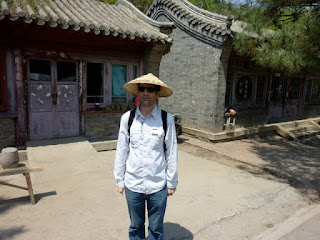We were dropped off at San Francisco International by Jeffrey and Linda after what could be our last Italian supper in months (Yeah, I know you can get Italian in Kathmandu, but I'm going to try to stick with local food).
Since there's a 40-lb limit on checked luggage and we were ever so slightly over, we stuffed our pant and jacket pockets full of random heavy items.
After an uneventful flight from San Francisco, we had a 10+ hour layover in Hong Kong. This gave us time to ride the Airport Express train into Kowloon. The train dumped us into a manicured sterile complex of highrises and designer malls that we could only escape from by using the airport shuttle to the Marco Polo Hotel.
We went to the historic clock tower (remanant of HK's colonial days), and this led us to the Avenue of Stars with stars and handprints of our all-time favorite kung-fu stars (like Bruce Lee!!!, Jet Li, Jackie Chan, Chow Yun Fat).
So what if it's just like the Hollywood Walk of Stars... it doesn't have a cool statue of Bruce Lee.
As we were walking down the Avenue, two 8-year-old girls accosted Alan, squealing in Mandarin and waving him towards their mother, who was clutching a camera. Since my knowledge of Mandarin is non-existent, I could not understand what they were saying. But I think that they may have a) confused him for someone famous (i.e. Mr. Bean who has always been well-loved by the Chinese) or b) never seen a white guy.
I wish I could've gotten the snap of a bemused Alan standing between two beaming little Chinese girls with their mother taking a photo.
After his 15 (er, 2) minutes of fame, we ate congee and vegetarian tomato/egg over rice (yes, Mom, you can get veg food in HK). We took the Star Ferry to Hong Kong Island and climbed up the Escher-like escalators and stairs close to the tram for Victoria Peak.
Soon it was time to boogie back to the airport to board our flight to KTM. At the HK airport, we checked our email and found out that there was a transportation strike in Nepal, which is a somewhat common occurrence. The airline didn't seem to have much information, so we just decided to wait and see what would happen when we arrived.
The KTM airport was a low-tech affair with the security agents haphazardly X-raying bags, while arbitrarily letting others pass through without being X-rayed. After realizing our hotel pickup wasn't going to materialize, we took an exciting taxi ride (think lots of honking, near misses with bicyclists, driving towards oncoming traffic... not unlike riding in a Parisian taxi) to our hotel at midnight.
Sleep was lovely.

















































